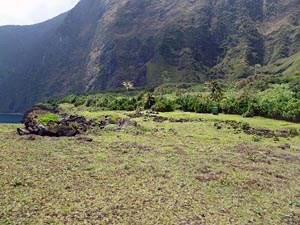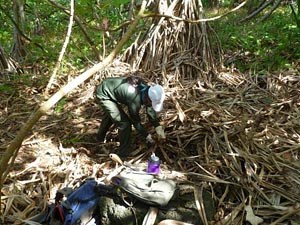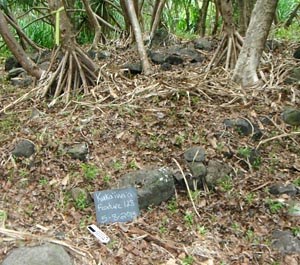Last updated: December 14, 2022
Article
Archeology at the Kuka’iwa’a Landshelf, Kalaupapa

NPS photo.
Kalaupapa National Historical Park, on Molokai Island, is best known as the isolated peninsula where people afflicted with Hansen’s Disease (leprosy) were sent between the years 1866-1965. However, the park also preserves thousands of archeological features which represent pre-leprosy settlement life. Underlying the historic settlement on the peninsula and in the adjacent valleys of the north shore, intact traditional Hawaiian dry set features indicate early life was characterized by agriculture. Recently, NPS staff conducted an archeological inventory of a remote area of the park known to have significant traditional Hawaiian features.
The National Historical Preservation Act Section 110 directs federal agencies to assume responsibility for the preservation of historic properties within their care. Performing baseline surveys is essential for understanding the preservation needs, threats and vulnerabilities of archeological sites within the care of the park. In April and May 2013, cultural resource staff from Kalaupapa National Historical Park inventoried a remote landshelf on Molokai’s north shore, called Kuka’iwa’a.

NPS photo.
The Kuka’iwa’a landshelf is on the border of Waikolu Valley in eastern Molokai and accessible only by boat or helicopter. Waikolu Valley is on the windward side of the island, which sees high average rainfall due to moisture-laden trade winds. While no perennial streams were located on the landshelf, intermittent waterfalls and rainfalls would have provided a fresh water source. The area is heavily vegetated with a native coastal forest of lauhala (Pandanus tectorius) and hau (Hibiscus tiliaceus), both important plants in Hawaiian culture. Hau provided wood (canoe outriggers, tools), cordage, and medicine, and lauhala leaves were used for weaving.
Prior archeological surveys at Kuka’iwa’a focused on the exposed coastal shelf, which contains a concentration of platforms and c-shaped shelters, as well as lithics and shell. To expand on prior work and learn more about cultural and historical use of the landshelf, survey needed to be done on the heavily vegetated interior. Cutting gridlines was not feasible due to the small crew, short time frame, and destruction to the native forest. Instead, survey was conducted along a corridor running makai/mauka (ocean to mountain) that was previously cut in by the park’s natural resources management division. Features visible from the corridor were recorded and mapped, and although not systematic, the survey gave a representation of the types of structures on the landshelf.

NPS photo.
Park archeologist Mary Jane Naone and museum technician Kellie Ellis recorded a total of 38 traditional Hawaiian features and subfeatures, including 11 enclosures, 16 terrace segments, 5 platforms, one possible water feature, 3 alignments and 2 mounds. Early dates for neighboring valleys indicate Hawaiians settled the north shore of Molokai around 1,000 years ago, although the landshelf may have been settled later. The features indicate that early Hawaiians used the terraces and mounds for dryland farming, maximizing water retention from rainfall and reducing erosion on the colluvial slope. Low stone walls and terraces may have served as boundaries, for soil accumulation and wind aversion. Multi-level platforms and enclosures may have been habitation complexes associated with the agricultural features. The landshelf also contains ceremonial features, or heiau.
This representative survey is a preliminary effort and further research is needed to reach a clearer understanding of population size on the peninsula. Research of similar dryland colluvial slope agriculture in Molokai’s north shore valleys has indicated the farming of sweet potato, bananas, ti plants, and yams, as well as breadfruit and arrowroot. Non-subsistence crops such as paper mulberry (or barkcloth), olona (for cordage), kava (ritual use), and kukui (candle nut) may also have been grown. Macrobotanical or pollen samples were not taken during the survey.
Kuka’iwa’a landshelf is an invaluable landscape rich with cultural and natural resources that deepen our understanding of Hawaiian history along Molokai’s north shore. Kalaupapa National Historical Park preserves pre-settlement use of the landscape as an important dimension in the interpretation of the past. Further archeological inventory and research will better inform our efforts to preserve and interpret the landscape for the education and inspiration of future generations.
By Mary Jane Naone, NPS archeologist, Kalaupapa National Historical Park
